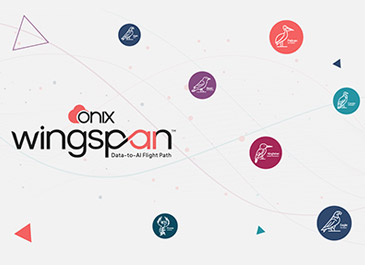In our recent webinar “No Data, No AI, How to Ensure You Get It Right,” Onix’s CMO, Jessica Wesley, and Dr. Phil Shelley, CSO, discussed the critical connection between high-quality data and the success of Artificial Intelligence (AI) projects. The conversation highlighted why so many AI initiatives fail and what steps companies can take to build a data foundation ready for AI.
The staggering failure rate of AI projects
Research cited in the webinar indicates a high failure rate for AI projects, with 85% failing to reach production. This is attributed primarily to a lack of high-quality data. Dr. Shelley noted that these data quality issues are particularly problematic in agentic models, where AI relies on the available data, which is often unclean, scattered, and ungoverned. To avoid these failures, there is a crucial need for governance, curation, consolidation, and sufficient data, including synthetic data.
Furthermore, 78% of enterprises are reportedly not ready for AI deployment due to weak data strategies. Dr. Shelley emphasized that successful AI projects require clear objectives with high-level management buy-in and AI-ready data foundations. These foundations must include governance, real-time data feeds, synthetic data, and business context. Successful projects typically demonstrate management buy-in, a performance-based output, and a clear improvement in business functionality.
The essential role of synthetic data
Synthetic data is critical for improving data quality and readiness for AI, addressing both data scarcity and privacy concerns. Dr. Shelley explained that Onix’s Kingfisher tool, a synthetic data generator, uses a context model to understand how data is used and its business context. This allows Kingfisher to generate large volumes of high-fidelity, anonymous synthetic data for training AI models, overcoming limitations related to data scarcity and privacy without using real production data. This is particularly important in industries dealing with sensitive information like financial or healthcare data.
Breaking down data silos
A common challenge highlighted was the issue of data silos. Dr. Shelley stated that cloud adoption, especially Google Cloud, is crucial for modernizing data infrastructure and breaking down these silos. By bringing data together in near real-time, companies can apply proper governance and business context. He advocated for a business case-by-business case approach to data consolidation rather than large “big bang” projects to drive value quickly.
The future of data interaction
Looking ahead, the future of data interaction is envisioned as users being able to ask natural language questions to data and receive real-time, accurate answers relevant to their specific roles or personas. This requires clean, real-time, well-governed data and well-trained models that continuously incorporate feedback. Dr. Shelley believes that persona-based expert systems delivering meaningful, accurate, and real-time insights are the future. Onix’s Wingspan platform is designed to facilitate this transition from legacy systems to the future of data interaction through intelligence and automation. This shift replaces the slower cycle of traditional BI reports and manual analysis.
High-quality, well-governed, and accessible data is the non-negotiable foundation for successful AI deployment. Companies must invest in modernizing their data infrastructure and strategies to unlock the full potential of AI and enable the exciting future of data interaction.
To learn more, watch the full webinar recording here and reach out to Onix to learn more about our powerful services to help you in your data and AI journey.









